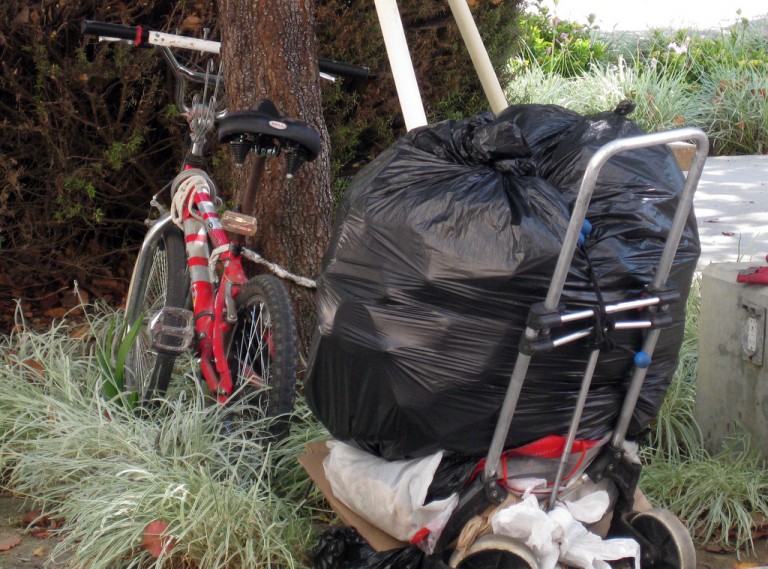
So Young dijo que en un buen día, si ella recolecta suficientes botellas de plástico y latas de aluminio puede ganar entre $7 y $10 en un centro reciclaje.
By DENISE VASTOLA
She darts between cement picnic tables with bright yellow umbrellas protecting its diners from the hot Noonday sun in the outdoor dining area. The 77-year-old woman, who washes and wears the same outfit every day, knows she must be fast and snatch plastic bottles and cans from the trash before employees change out garbage liners. To be cliché, one person’s trash is another person’s treasure.
So Young, (not her real name) can no longer make ends meet just on her modest pension and Social Security and she does not want her son to know she needs the money from collecting empty beverage containers.
“Rent is high. I use two fans in my apartment, not the air conditioner, because it costs too much,” said So Young who lives close to California State University Northridge. “I am a diabetic and my doctor told me to get exercise, so this is how I get exercise.”
The latest census bureau data indicate median income fell for families, including native- and foreign-born households. These declines in income coincide with the beginning of the recession in December of 2007. (See table)
While census bureau data for 2008 indicates official national poverty rate in 2008 was 13.2 percent, up from 12.5 percent in 2007, the percent of people reaching poverty status in the past 12 months in Los Angeles County has increased from 14.6 percent to 15.2 percent.
At the same time income has been dropping and poverty rising, recycling beverage containers for money has gone up.
“While sales of California Refund Value beverage containers remained constant in 2007 and 2008, there was a significant increase in CRV containers returned for refunds in 2008,” said Mark Oldfield, recycling specialist for the California Department of Conservation. “This means that while the amount of CRV paid into the state’s recycling fund remained roughly the same in 2007 and 2008, the amount of CRV paid out in refunds increased substantially.”
Historically, about a third of the volume of CRV material recycled in California comes from Los Angeles County, said Oldfield.
As news reports each month reveal that unemployment rates continue to soar and the economy continues to languish, people who count on money earned from selling recyclables find they are not only making less money as the price for recycled material plummets, but also competing with more individuals collecting the items to turn in for cash.
“Some of my neighbors and other people I know have used recycling as a principal source of income for the past two years,” said Arturo Ybarra, director of the Watts-Century Latino Organization. “Every day, more and more people are looking for cans, bottles and scrap metals.”
Construction workers were hit particularly hard when the housing market collapse was followed by the recession. Ybarra said many of the unemployed construction workers invested money in pick up trucks and began collecting discarded metals and selling them to recycling centers. The fluctuation of scrap prices, which has been mainly downward, has contributed to the financial burden of making ends meet.
As the recession worsened, the price of scrap metals sold on the commodities market plunged.
The reason, according to Dan Sandoval, a reporter with Recycling Today, is the demand for scrap metals dropped. Commodity prices are driven by global trends. If China and the American auto industry are all buying scrap metal, the prices remain higher. Conversely, if there is a surplus of scrap, but purchasing drops, so do prices.
Meanwhile, Ybarra said competition for collecting recyclables is growing.
“This is affecting families with mixed immigration status,” said Ybarra. “Parents not documented can’t get a job. I see grandmas, mothers and children collecting bottles and cans to bring food to the table.”
In Los Angeles, people who recycle beverage bottles and cans have the option to redeem them at locations offering CRV only, which is 5 cents for containers less than 24 ounces and 10 cents for containers 24 ounces or more. This type of operation, many times found in the parking lot of a large supermarket, typically gives refunds based on the number of beverage containers returned.
Other locations, typically larger recycling centers that also process paper and cardboard, may offer CRV plus a few cents for scrap value. These bottles and cans are redeemed by the pound.
Diana Jamgotchian of Chatsworth brings her beverage containers to Valley Recycling in Northridge. On this trip, her redemption value for 7 lbs of aluminum cans, 5.5 lbs of plastic beverage bottles, 5 lbs of plastic milk cartons, and 18 lbs of glass bottles total $20. 53.
For the Jamgotchian family, the money they get from recycling two to three times a year goes toward the kids’ school supplies. Yet others recycle to survive.
“I see people going in trash cans,” said Jamgotchian. “They are trying to get by. They are unemployed. I think they do it because they don’t have any other means of income.”
Tags: Denise Vastola Recycling










